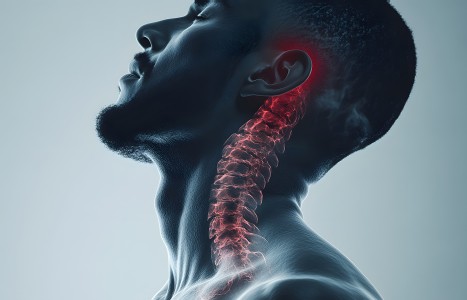Because they have yet to pass national legislation protecting the chiropractic profession, Japanese DCs are in a similar situation that U.S. DCs faced. We were fortunate enough to be able to pass chiropractic licensure state by state. The DCs in Japan must accomplish this nationally, which has proved to be an extremely difficult task. And in spite of their efforts, Japanese DCs are currently faced with two chiropractic professions.
Sacroiliac Sprain Syndrome
A 34-year-old female presented with a one-year history of right-sided low back and right limb pain. The initial injury was purportedly sustained while lifting a heavy box at home. The pain persisted, and there had been no significant improvement, despite numerous varieties of medical conservative treatment for "sciatica," that consisted of two weeks of physical therapy, painkillers, and muscle relaxants. Her medical generalist (an osteopath) had prescribed back exercises, but these seemed to aggravate the symptoms. On initial presentation she reported unilateral low back and posterior limb pain worsened by seated and weightbearing activity. The pain was worse with physical activity described as tennis matches twice a week.
The patient experienced similar pain, but to a lesser extent, during her pregnancies over a decade ago.
Initial examination yielded that standing on the involved side aggravated her symptoms. She had a positive Patrick's, Ely's and Yeoman's testing. There was tenderness to palpation over the sacroiliac joints bilaterally, though worse on the right side. She had positive straight-leg-raising maneuver bilaterally. The sciatic notch was mildly tender to digital examination. On hip clearance examination with knee to chest, the patient complained of considerable pain in the sacroiliac region. Neuromuscular examination was unremarkable, except for hypesthesia along the lateral aspect of the foot and posterior aspect of the calf.
Plain film examination of the hips included AP pelvis and true lateral. (The AP view should include the entire pelvis.) A limited two-view with angle study of the sacroiliac regions was obtained. These studies are useful for patients with strong clinical suspicion of hip and sacroiliac pathology. (Commonly in sacroiliac sprain syndrome roentgenograms of the lumbosacral spine and pelvis are unremarkable but clinically useful in ruling out other conditions.) There were proliferative osteophytes (overgrowth of bone-forming hard bars), left sacroiliac joint space narrowing, and moderate superior-lateral hip joint space narrowing with bony buttressing of the right femoral neck area demonstrated. The left iliac demonstrated a large expansile radio-opaque tumor that was honeycomb in appearance. The acetabuli and remaining left hip joint spaces were well maintained.
Upon further clinical questioning, the patient noted she had forgotten to mention that each year her GP monitored via x-ray a tumor that had been described to her as benign. She had been told that she was being monitored for possible surgical consideration. (She denied any orthopedist evaluation or further diagnostic study.) Immediately, a CT scan was obtained with orthopedic referral that confirmed the benign nature of the lesion. Yearly x-rays as a source of monitoring was discouraged due to unnecessary radiation exposure, considering the patient was still of childbearing age. (A clinical note of interest was the congenital absence of the right piriformis.)
Discussion
Sacroiliac sprain syndrome often passes unrecognized in the medical community, and is commonly mislabeled as sciatica. It is one of the most common disabling disorders seen in the practice of chiropractic.
The sacroiliac joints are among the strongest and most stable diarthrodial joints of the human body. These joints obtain much of their stability from the congruity of the sacral and iliac articular surfaces. The sacrotuberous and sacrospinous ligaments hold the inferior sacrum close to the posterior pelvis to counteract the rotational force or torque created by body weight.
The size, shape, and contour of sacroiliac joints vary considerably, even from side to side. Considerable shear forces occur with stress, as little stability is present except for the ligaments.
The sciatic nerve trunk lies directly adjacent to the lower anterior third of the sacroiliac joint, with nothing intervening but the joint capsule. (An inflamed sacroiliac joint can irritate the sciatic nerve at this level.) During pregnancy the pelvic ligaments relax due to the effects of Relaxin hormone, allowing greater motion at the sacroiliac joint. During pregnancy, and for a short period postpartum, there is a greater risk of developing a sacroiliac sprain during this period of ligamentous laxity. Traditionally, chiropractors have been trained to recognize this condition.
Treatment
This patient was treated three times a week for six weeks. Symptoms failed to resolve until a sacroiliac brace was utilized during the second treatment week (fifth session), and advised to discontinue all tennis activities due to shear stress until treatment was completed.
At the final visit, the patient was evaluated to determine the clinical response to chiropractic treatment, which consisted of prone right-sided sacroiliac adjustments primarily consisting of contact points on ischial tuberosity for flexion restriction or involved side-up posture. Adjustive technique for the lumbosacral spine included mammillary process contract for rotation and lateral bending restrictions. Ultrasound with trigger point head, and myofascial release with digital ischemic pressure was utilized as adjunctive therapy. She was taught to recognize activities that would aggravate the condition and to be able to distinguish the trigger point distribution from true sciatica. A stretch-conditioning muscle program was prescribed during the final week of care for use at a local gym, with emphasis on muscle balancing with respect to her disadvantage of a congenitally absent pirformis.
The case illustrates the clinical ability of the chiropractor to detect neuromusculoskeletal abnormalities with history and examination. Based upon the final clinical evaluation, the patient had a good outcome with marked improvement in pain level, appropriate medical orthopedic referral, appropriate special testing and appropriate patient education of congenital and degenerative abnormalities detected. To date, she is able to perform lifting and play tennis without any significant problems.
References
- Gatterman MI. Disorders of the Pelvic Ring: Chiropractic Management of Spine Related Disorders. Williams & Wilkins, 1990, 7; 112-127.
- Simmons DG. Myofascial Pain Due to Trigger Points. International Rehabilitation Medicine Association, IRMA Monograph Series Number 1, Nov 1987.
- Travell JG, Simmons DG. Myofascial Origins of low back pain. Postgraduate Medicine, Low Back Pain, Part I, Vol. 73/No 2/ February 1983.
- Gerwin RD. The Management of Myofascial Pain Syndromes. Journal of Musculoskeletal Pain (The Haworth Press, Inc) Vol. I, No. 314, 1993, pp. 83-94.
- Travell JG, Simmons DG. Myofascial Pain and Dysfunction: The Trigger Point Manual. Williams & Wilkins, 1992.
Nancy Molina, DC
San Juan Capistrano, California


